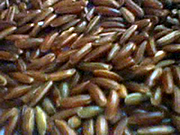Camargue red rice
Variety of red rice grown in the Camargue region of France
Camargue red rice is a variety of rice cultivated in the Camargue region of southern France. This unique type of rice is known for its distinctive red color and nutty flavor, which makes it a popular choice in various culinary dishes. The cultivation of Camargue red rice is an integral part of the region's agricultural heritage and contributes to the local economy.
History[edit | edit source]
The cultivation of rice in the Camargue region began in the 16th century, but it was not until the 20th century that red rice became a significant crop. The unique environmental conditions of the Camargue, with its saline soils and Mediterranean climate, provide an ideal setting for growing this type of rice. Over the years, Camargue red rice has gained recognition for its quality and flavor, becoming a staple in French cuisine.
Cultivation[edit | edit source]
Camargue red rice is grown in the wetlands of the Camargue, where the Rhône River meets the Mediterranean Sea. The rice fields are flooded with water from the river, which helps to control weeds and pests naturally. The red color of the rice is due to the presence of anthocyanins in the bran layer, which also contribute to its antioxidant properties.
The cultivation process involves several stages, including planting, flooding, and harvesting. The rice is typically sown in April and harvested in September. The unique growing conditions and traditional farming methods used in the Camargue contribute to the rice's distinctive characteristics.
Characteristics[edit | edit source]
Camargue red rice is known for its chewy texture and nutty flavor. The grains are medium-sized and have a reddish-brown color due to the bran layer. Unlike white rice, which is milled to remove the bran, red rice retains this layer, providing additional nutrients and fiber.
The rice is often used in salads, pilafs, and as a side dish. Its robust flavor pairs well with a variety of ingredients, making it a versatile component in many recipes.
Nutritional Value[edit | edit source]
Camargue red rice is a whole grain, meaning it retains all parts of the grain kernel, including the bran, germ, and endosperm. This makes it a rich source of dietary fiber, vitamins, and minerals. It is particularly high in magnesium, phosphorus, and iron, and contains antioxidants that are beneficial for health.
Culinary Uses[edit | edit source]
In French cuisine, Camargue red rice is often used in salads, risottos, and as an accompaniment to meat and fish dishes. Its nutty flavor and chewy texture make it a popular choice for chefs looking to add depth and complexity to their dishes.
Related Pages[edit | edit source]
Search WikiMD
Ad.Tired of being Overweight? Try W8MD's NYC physician weight loss.
Semaglutide (Ozempic / Wegovy and Tirzepatide (Mounjaro / Zepbound) available. Call 718 946 5500.
Advertise on WikiMD
|
WikiMD's Wellness Encyclopedia |
| Let Food Be Thy Medicine Medicine Thy Food - Hippocrates |
Translate this page: - East Asian
中文,
日本,
한국어,
South Asian
हिन्दी,
தமிழ்,
తెలుగు,
Urdu,
ಕನ್ನಡ,
Southeast Asian
Indonesian,
Vietnamese,
Thai,
မြန်မာဘာသာ,
বাংলা
European
español,
Deutsch,
français,
Greek,
português do Brasil,
polski,
română,
русский,
Nederlands,
norsk,
svenska,
suomi,
Italian
Middle Eastern & African
عربى,
Turkish,
Persian,
Hebrew,
Afrikaans,
isiZulu,
Kiswahili,
Other
Bulgarian,
Hungarian,
Czech,
Swedish,
മലയാളം,
मराठी,
ਪੰਜਾਬੀ,
ગુજરાતી,
Portuguese,
Ukrainian
Medical Disclaimer: WikiMD is not a substitute for professional medical advice. The information on WikiMD is provided as an information resource only, may be incorrect, outdated or misleading, and is not to be used or relied on for any diagnostic or treatment purposes. Please consult your health care provider before making any healthcare decisions or for guidance about a specific medical condition. WikiMD expressly disclaims responsibility, and shall have no liability, for any damages, loss, injury, or liability whatsoever suffered as a result of your reliance on the information contained in this site. By visiting this site you agree to the foregoing terms and conditions, which may from time to time be changed or supplemented by WikiMD. If you do not agree to the foregoing terms and conditions, you should not enter or use this site. See full disclaimer.
Credits:Most images are courtesy of Wikimedia commons, and templates, categories Wikipedia, licensed under CC BY SA or similar.
Contributors: Prab R. Tumpati, MD


